DU ZHENJUN
d.c. (da capo)
DU ZHENJUN, new solo exhibition
18 January – 25 February ext. 5 March 2024
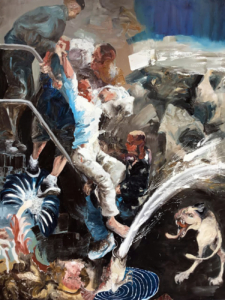
Du Zhenjun, Sens éternel (eternal meaning, Ewige Bedeutung), 2023, oil on canvas, 250x200cm
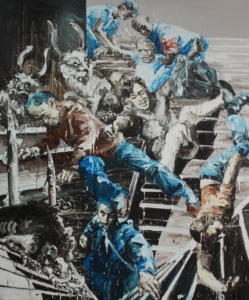
Du Zhenjun, escaliers (stairs , Treppe), 2023, oil on canvas, 250x200cm, private collection, Munich area
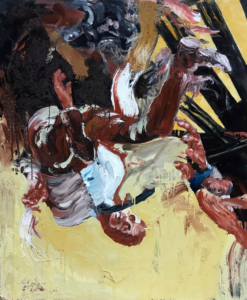
Du Zhenjun, petit escalier (ou chute), 2023, oil on canvas, 162x130cm
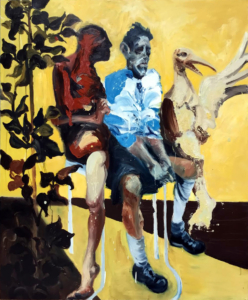
Du Zhenjun, Strange, 2023, oil on canvas, 162x 130 cm
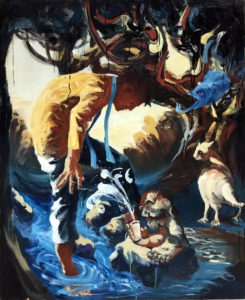
Du Zhenjun, under the shadows, 2023, oil on canvas, 162x130cm

Du Zhenjun, Fall, 2023, oil on canvas, 162x130cm

Du Zhenjun, Mystère étrange, 2023, oil on canvas, 150x150cm
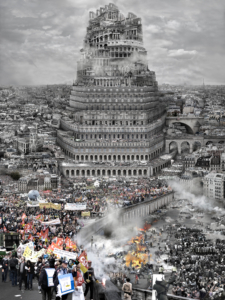
Du Zhenjun, Old Europe, 2011, Diasec photographie, 160x120cm, /6

Du Zhenjun, Reference 113, Eating , Babel world, 2012, Diasec photographie, 44 1/10 × 35 2/5 in 112 × 90 cm Edition of 8

Du Zhenjun, travail préparatoire , Agressions, 2012, Ink and aquarelle on paper, 47 1/5 × 35 2/5 in or 120 × 90 cm

Du Zhenjun, drawing, 2011 Mixed media, 15 7/10 × 15 7/10 in 40 × 40 cm
„da capo“
New solo exhibition with Du Zhenjun (new series)
(17)-18 January– 25 February 2024
Music lovers know the abbreviation „d. c.“ as the playing instruction to start a piece of music da capo, i.e. from the beginning, at the designated point.
With this new exhibition in Munich, Du Zhenjun, an avant-garde artist recognized worldwide as a pioneer in the fields of artistic photography and video, returns to the roots of his work.
Born in Shanghai in 1961, Dun Zhenjun grew up in the city’s French Concession. He later emigrated to France, first to Bordeaux in 1991, then to Paris. The artist took the gamble of first developing his talent with major art institutions before agreeing to work with art galleries, and owes part of his notoriety to numerous solo and group exhibitions and installations around the world. These include “Chien-Man” in 1997; „Présomption“ in 2000, which won the Installation Interactive prize; “Erase your trace in 2001”; „Vent“ in 2003; and „Global Fire“ in 2007.
Du Zhenjun’s work has also been a great success with museums and institutions in Germany. These include exhibitions in Munich’s Muffathalle in 2002, 2006 and 2008; his highly acclaimed intervention at the Martin Gropius-Bau Museum (Berlin) in 2007; and a solo show at the Z.K.M (Karlsruhe) in 2013, where he presented his „Babel Tower“ series, created between 2010 and 2012, a reflection on the human condition in a globalized, over-mediatized world.
Du Zhenjun has a particular interest in biblical themes and draws his inspiration from the great Renaissance masters such as Hieronymous Bosch and Pieter Bruegel the Elder, sprinkling his work with numerous hints and double meanings.
While his first major series revolved around the myth of the Babel Tower and the Colosseum, Du Zhenjun is now particularly interested in the world of Artificial Intelligence (AI), which he sees as the new lure of modern times. In a new painted narrative entitled „Second Hand“, he depicts humans overwhelmed by mythological or imagined creatures. This innovative work was unanimously acclaimed at the „Asia Now“ Art Fair in Paris in October 2023.
Most of the oils presented in the present exhibition are making their first gallery appearance. You will discover how Du Zhenjun now uses painting to explore the wanderings of peoples disrupted by crises. The role and place of the various creatures and human beings are worthy of the ancient masters, as the artist’s culture knows no boundaries. A true theater of animal-human passions plays out in the artist’s paintings, and their mutual respect proves the artist’s benevolence: we are far from the Manichean opposition where man overcomes an evil being. Faced with the tragedy of the world, Du Zhenjun offers us a cathartic art work which manages to reconcile the tragedy of its content with the playfulness of its presentation.
Works from the Babel Tower series are also displayed, providing the keys to understanding how the artist appropriates fragments of images from the Internet and assembles them using the collage technique. The process is slow and complex, involving preparatory work in ink and watercolor.
Du Zhenjun’s remarkable ability to tackle complex themes has been hailed by leading artists, world-class museums and foundations such as the Centre George Pompidou, as well as by international art collectors, who are increasingly joining his circle of admirers. His return to Munich is an opportunity to admire his works, and to invite them into your collections.
DA CAPO
Einzelausstellung mit dem Künstler DU ZHENJUN (Öl, Fotografie und Video)
18 Januar – 25 Februar 2024
Musikliebhaber kennen die Abkürzung „d. c.“ für die Spielanweisung, ein Musikstück da capo, d. h. von Anfang an, an der vorgesehenen Stelle zu beginnen.
Mit der neuen Ausstellung in München kehrt der weltweit als Pionier der künstlerischen Fotografie und des Videos anerkannte Avantgarde-Künstler Du Zhenjun zu den Wurzeln seiner Arbeit zurück.
Dun Zhenjun wurde 1961 in Shanghai geboren und wuchs in der französischen Konzession der Stadt auf. Später emigrierte er nach Frankreich, zunächst 1991 nach Bordeaux, dann nach Paris. Der Künstler entwickelte sein Talent zunächst bei großen Institutionen und arbeitete viel später mit Kunstgalerien. Er erlangte einen hohen Bekanntheitsgrad durch die zahlreichen Einzel- und Gruppenausstellungen weltweit. Dazu gehören „Chien-Man“ in 1997, „Présomption“ in 2000, das mit dem Preis für interaktive Installationen ausgezeichnet wurde, „Erase your Trace“ in 2001, „Vent“ in 2003 sowie „Global Fire“ in 2007.
Du Zhenjuns Arbeiten waren auch in Deutschland ein großer Erfolg in Museen und Institutionen, so z.B. bei seiner Einzelausstellung im Z.K.M (Karlsruhe) 2013, wo er seine zwischen 2010 und 2012 entstandene Serie „Babel Tower“ präsentierte, eine Reflexion über die conditio humana in einer globalisierten, übermediatisierten Welt, sowie seine hochgelobte Intervention im Martin Gropius-Bau Museum (Berlin) in 2007 und seine verschiedenen Einladungen in die Münchner Muffathalle 2002, 2006 und 2008.
Du Zhenjun hat ein besonderes Interesse an biblischen Themen und lässt sich von den großen Meistern der Renaissance wie Hieronymous Bosch und Pieter Bruegel dem Älteren inspirieren, wobei er sein Werk mit zahlreichen Doppelbedeutungen versieht.
Während sich seine erste große Geschichte um den Mythos des Turmbaus zu Babel und des Kolosseums drehte, interessiert sich Du Zhenjun nun besonders für die Welt der künstlichen Intelligenz (KI), die er als neue Verlockung der modernen Zeit betrachtet. In einer neuen gemalten Erzählung mit dem Titel „Second Hand“ stellt er Menschen dar, die von mythologische oder imaginäre Kreaturen überwältigt werden. Dieses innovative Werk wurde auf der Messe „Asia Now“ in Paris im Oktober 2023 einhellig gelobt.
Die meisten ausgestellten Ölgemälde sind erstmals in einer Galerie zu sehen. Sie werden entdecken, wie Du Zhenjun nun die Malerei nutzt, um die Wanderungen von Völkern zu erforschen, die von Krisen heimgesucht werden. Die Rolle und der Platz der verschiedenen Kreaturen und Menschen, inspiriert von der Mythologie oder der Welt der KI, ist den alten Meistern würdig, denn die Kultur des Künstlers kennt keine Grenzen. Es ist ein wahres Theater der tierisch-menschlichen Leidenschaften, das sich in seinen Bildern abspielt, wobei der gegenseitige Respekt das Wohlwollen des Künstlers aufzeigt: Wir sind weit entfernt von der manichäischen Opposition, in der der Mensch ein böses Wesen besiegt. Angesichts der Tragödie der Welt bietet uns Du Zhenjun eine kathartische Malerei, der es gelingt, die Tragik ihres Inhalts mit der Verspieltheit ihrer Darstellung in Einklang zu bringen.
Im hinteren Teil der Ausstellung sind Werke aus der Serie Babel Tower zu sehen, die uns zeigen, wie der Künstler sich Bildfragmente aus dem Internet aneignet und sie mit der Technik der Collage zusammensetzt. Der Prozess ist langsam und komplex und umfasst Vorarbeiten in Tusche und Aquarell.
Du Zhenjuns bemerkenswerte Fähigkeit, sich mit komplexen Themen auseinanderzusetzen, wird von führenden Künstlern, Museen und Stiftungen von Weltrang wie dem Centre George Pompidou und internationalen Sammlern, die sich zunehmend seinem Kreis von Bewunderern anschließen, gewürdigt. Seine Rückkehr nach München ist eine Gelegenheit, seine Werke zu bewundern und sie in Ihre Sammlungen einzuladen.
DA CAPO
Exposition solo de l’artiste DU ZHENJUN (Huile, photo et vidéo)
18 Janvier – 25 Février 2024
Les mélomanes connaissent sous l’abrégé “ d. c.” l’instruction de jeu consistant à recommencer un morceau de musique da capo, c’est-à-dire depuis le début, à l’endroit ainsi désigné.
Avec cette nouvelle exposition munichoise, Du Zhenjun, artiste d’avant-garde reconnu mondialement comme un pionnier dans les domaines de la photographie et de la vidéo artistique, revient aux sources de son œuvre.
Né en 1961 à Shanghai, Dun Zhenjun grandit dans la concession française de la ville. Il émigrera ensuite en France, d’abord à Bordeaux en 1991, puis à Paris. L’artiste prend le pari de d’abord développer son talent auprès de grandes institutions artistiques avant d’accepter de travailler avec les galeries d’art et doit une part de sa notoriété à de nombreuses expositions1 et installations, en solo ou collectives, à travers le monde entier. Parmi celles-ci, « Chien-Man » en 1997 ; « Présomption » en 2000, qui se voit décerner le prix Installation Interactive ; « Erase your Trace » 2001 ; « Vent » en 2003 ; ou encore « Global Fire » en 2007.
Du Zhenjun connaitra également un succès marqué auprès des musées et institutions allemandes, par exemple avec ses différentes invitations à la Muffathalle de Munich en 2002, 2006 et 2008 ; sa très remarquée intervention au musée Martin Gropius-Bau (Berlin) en 2007 ; ou son exposition solo au Z.K.M (Karlsruhe) en 2013, où il présente sa série « Babel Tower », réalisée entre 2010 et 2012, une réflexion sur la condition humaine au sein d’un monde globalisé et surmédiatisé.
Du Zhenjun manifeste un intérêt particulier pour les thèmes bibliques et puise son inspiration auprès de grands maîtres de la Renaissance tels Hieronymous Bosch ou Pieter Bruegel l’ancien, parsemant son œuvre de nombreux allusions et doubles-sens.
Si son premier grand récit s’articule autour du mythe de la tour de Babel et du Colisée, Du Zhenjun porte aujourd’hui un intérêt particulier au monde de l’intelligence artificielle (IA), qu’il perçoit comme le nouveau leurre des temps modernes. Dans un nouveau récit en peinture intitulé “Seconde main”, il met en scène des humains débordés par des créatures mythologiques ou imaginaires. Ce travail novateur a été unanimement salué lors de la foire parisienne « Asia Now » en octobre 2023.
La plupart des huiles présentées dans notre double espace font leur première apparition en galerie. Vous découvrirez comment Du Zhenjun explore désormais par la peinture les errances des peuples bouleversés par les crises. La place des êtres humains et des diverses créatures est digne des maître anciens, la culture de l’artiste ne connaissant aucune barrière. C’est un véritable théâtre des passions animaux-humains qui se joue dans ses tableaux, avec un respect mutuel prouvant la bienveillance de l’artiste : on est loin de l’opposition manichéenne où l’homme terrasse un être maléfique. Face à la tragédie du monde, Du Zhenjun nous offre une peinture cathartique qui parvient à concilier le tragique de son contenu avec le caractère ludique de sa présentation.
Vous découvrirez également dans l’espace du fond des œuvres de la série Babel Tower, qui vous donneront les clés de compréhension nécessaires à appréhender la manière dont l’artiste s’approprie des fragments d’images sur internet, qu’il assemble en recourant à la technique du collage. Ce processus est lent et complexe, passant par des travaux préparatoires à l’encre de chine et à l’aquarelle.
Du Zhenjun possède une capacité remarquable à aborder des thématiques complexes, saluée par les artistes les plus grands, les fondations et musées de rang mondial, tels le Centre George Pompidou, et les collectionneurs internationaux, toujours plus nombreux à s’ajouter au cercle de ses admirateurs. Son retour à Munich est l’occasion de venir admirer ses œuvres, et de les inviter dans vos collections.
